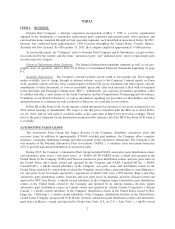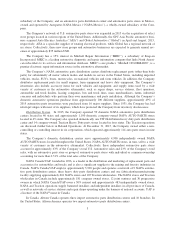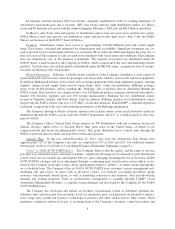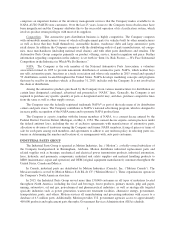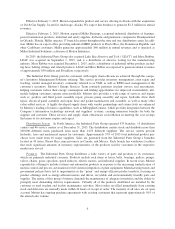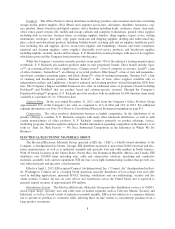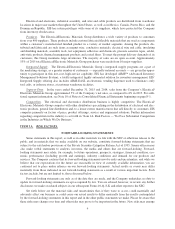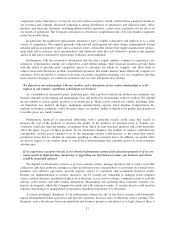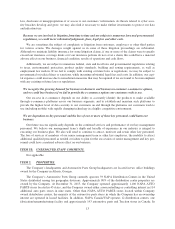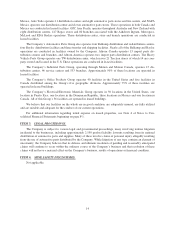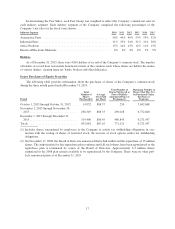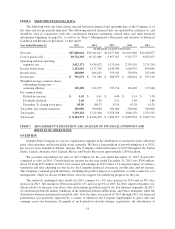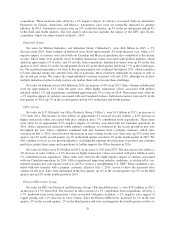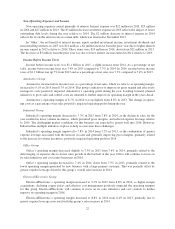Napa Auto Parts 2015 Annual Report Download - page 18
Download and view the complete annual report
Please find page 18 of the 2015 Napa Auto Parts annual report below. You can navigate through the pages in the report by either clicking on the pages listed below, or by using the keyword search tool below to find specific information within the annual report.competitors reduce their prices, we may be forced to reduce our prices, which could result in a material decline in
our revenues and earnings. Increased competition among distributors of automotive and industrial parts, office
products and electronic materials, including internet-related initiatives, could cause a material adverse effect on
our results of operations. The Company anticipates no decline in competition in any of its four business segments
in the foreseeable future.
In particular, the market for replacement automotive parts is highly competitive and subjects us to a wide
variety of competitors. We compete primarily with national and regional auto parts chains, independently owned
regional and local automotive parts and accessories stores, automobile dealers that supply manufacturer replace-
ment parts and accessories, mass merchandisers and wholesale clubs that sell automotive products and regional
and local full service automotive repair shops, both new and established.
Furthermore, both the automotive aftermarket and the office supply industry continue to experience con-
solidation. Consolidation among our competitors could further enhance their financial position, provide them
with the ability to provide more competitive prices to customers for whom we compete, and allow them to
achieve increased efficiencies in their consolidated operations that enable them to more effectively compete for
customers. If we are unable to continue to develop successful competitive strategies or if our competitors develop
more effective strategies, we could lose customers and our sales and profits may decline.
We depend on our relationships with our vendors, and a disruption of our vendor relationships or a dis-
ruption in our vendors’ operations could harm our business.
As a distributor of automotive parts, industrial parts, office products and electrical/electronic materials, our
business depends on developing and maintaining close and productive relationships with our vendors. We depend
on our vendors to sell us quality products at favorable prices. Many factors outside our control, including, with-
out limitation, raw material shortages, inadequate manufacturing capacity, labor disputes, transportation dis-
ruptions or weather conditions, could adversely affect our vendors’ ability to deliver to us quality merchandise at
favorable prices in a timely manner.
Furthermore, financial or operational difficulties with a particular vendor could cause that vendor to
increase the cost of the products or decrease the quality of the products we purchase from it. Vendor con-
solidation could also limit the number of suppliers from which we may purchase products and could materially
affect the prices we pay for these products. In our automotive business, the number of vendors could decrease
considerably, and the prices charged to us by the remaining vendors could increase, to the extent that vehicle
production slows due to a decline in consumer spending or other economic factor. In addition, we would suffer
an adverse impact if our vendors limit or cancel the return privileges that currently protect us from inventory
obsolescence.
If we experience a security breach, if our internal information systems fail to function properly or if we are
unsuccessful in implementing, integrating or upgrading our information systems, our business operations
could be materially affected.
We depend on information systems to process customer orders, manage inventory and accounts receivable
collections, purchase products, manage accounts payable processes, ship products to customers on a timely basis,
maintain cost effective operations, provide superior service to customers and accumulate financial results.
Despite our implementation of security measures, our IT systems are vulnerable to damages from computer
viruses, natural disasters, unauthorized physical or electronic access, power outages, computer system or network
failures, cyber-attacks and other similar disruptions. Maintaining and operating these measures requires con-
tinuous investments, which the Company has made and will continue to make. A security breach could result in
sensitive data being lost, manipulated or exposed to unauthorized persons or to the public.
A serious prolonged disruption of our information systems for any of the above reasons could materially
impair fundamental business processes and increase expenses, decrease sales or otherwise reduce earnings. Fur-
thermore, such a breach may harm our reputation and business prospects and subject us to legal claims if there is
12


